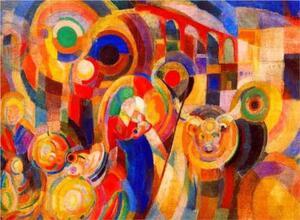Retrospective Exhibit of work by Sonia Delaunay opens in Buffalo
On this day, the largest survey to date of Ukraine-born French artist Sonia Delaunay’s (1885–1979) work opened at the Albright-Knox Art Gallery in Buffalo, New York. It featured more than 200 works created over the course of eight decades, including decorative arts projects, paper works, and numerous paintings. In conjunction with her paintings, Assistant Curator Suzanne Crane organized a collection of films, concerts, poetry readings, lectures, and a family workshop in an effort to highlight the plethora of activities that Delaunay participated in during the 1920s. This exhibition eventually traveled to the Museum of Art, Carnegie Institute in Pittsburgh, The Museum of Fine Arts in Houston, The High Museum of Art in Atlanta, The Grey Art Gallery, and Study Center at New York University, The Art Institute of Chicago, and the Musee d'art contemporain in Montreal. It was described as a “happy salute to an artist too long in bondage to her husband’s reputation,” as well as an “excellent representation of almost every important Sonia Delaunay oeuvre” in the New York Times.
Delaunay was a multi-disciplinary artist, working in collage, textiles, painting, theatrical costume, printmaking, and interior design. She was a key figure in the Parisian avant-garde movement, and knew many famous artists such as Picasso, Braque, Tzara, Diaghilev, and of course, husband and fellow painter Robert Delaunay. In her work, she was completely fascinated by and devoted to color; exploring new ideas about color theory with her husband, she used bright hues in everything from paintings to fashion pieces.
Delaunay was born Sara Élievna Stern in Odessa, Ukraine, to two impoverished Jewish parents, the youngest of three. She was sent to live with her mother’s wealthy brother Henri Terk and his wife in St. Petersburg, Russia. She travelled extensively throughout her life, and location heavily influenced her work. While living in Madrid in 1917, she started designing costumes for a production of Cléopatre. Following this, she continued to design theatrical and ballet costumes for many years. In 1921, she opened a design and fashion shop known as Casa Sonia, which attracted many glamorous customers such as Hollywood actress Gloria Swanson. Her textile designs became so popular that in 1924, she began her own company with Jacques Herm. She eventually began a relationship with department store Metz and Co. based in Holland, proving that women have the power to leave a lasting impression on the art and design world.
After her husband’s death in 1941, her life became quite difficult, and she survived mostly by selling her own designs and her late husband’s paintings. As a Jewish woman, during World War II she was acutely aware of the dangers that surrounded her, which forced her to move frequently, as she was worried about being arrested. On one specific occasion in Cannes, she was questioned about her middle name, “Stern.” According to multiple accounts, she refused to show fear, and by standing her ground was able to successfully board her train and avoid being captured. During this time, war was a constant in her life; she would often hear gunfire and watch the German troop activity from as close as her hotel windows. After the war, she returned to Paris, with the goal of making sure her late husband’s work received due credit for its excellence; once she felt that she had succeeded, she focused on her own work until her death in 1979 in Paris.
The first living female artist and second living artist to ever have a retrospective exhibition at the Louvre in 1964, Delaunay was a true radical; ahead of her time, and extremely relevant to ours, she was a pioneer in female inclusion to the art scene, setting the stage of possibility for many female artists to come.
This entry was created for This Week in History as part of a course on the history of American Jews and Social Justice taught by Karla Goldman at the University of Michigan, Winter 2021.
Sources: Albright Knox, Sonia Delaunay: A Retrospective, https://www.albrightknox.org; Wikiart, Sonia Delaunay, https://www.wikiart.org; The Tate, The EY Exhibition: Sonia Delaunay, https://www.tate.org.uk; The Art Story, Sonia Delaunay: Biography and Legacy, https://www.theartstory.org/; New York Times Archive, ART VIEW; Sonia Delaunay --A Pioneer Modernist ART VIEW, https://www.nytimes.com/1980/02/17/archives/art-view-sonia-delaunay-a-pioneer-modernist-art-view.html?searchResultPosition=4; New York Times Archive, Art; Sonia Delaunay and ‘Pure Color,’ https://www.nytimes.com/1980/11/21/archives/art-sonia-delaunay-and-pure-color.html?searchResultPosition=1



